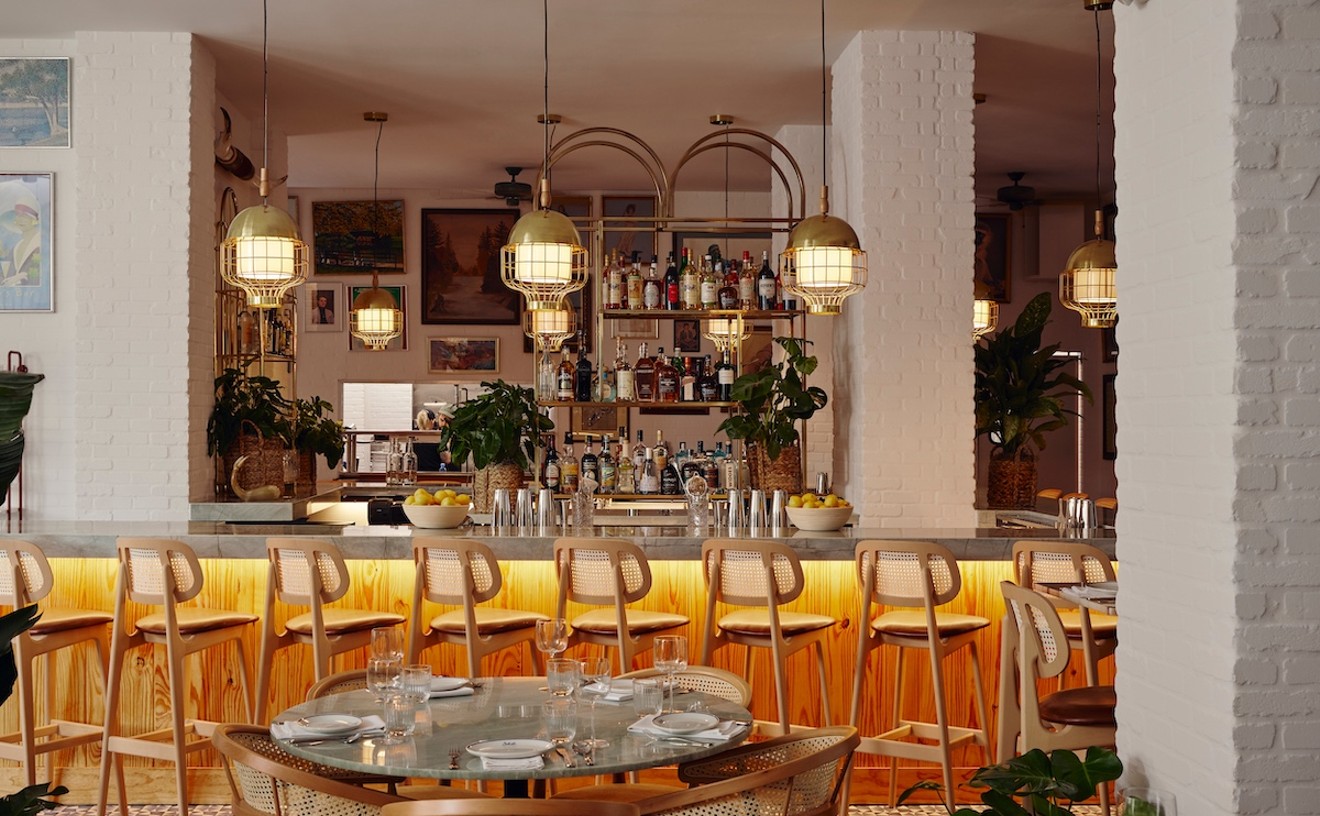There was nothing wrong with the old Alta Mar. The comfy room, fresh seafood, friendly service, and affordable prices garnered a rare troika of approval from critics, locals, and tourists alike — so much so that its off-the-beaten-track locale on Lincoln Road, west of the pedestrian mall, was never an obstacle to filling every indoor and outdoor seat. By all appearances, Alta Mar was turning a tidy profit. So it came as a surprise when owner Claudio Giordano announced last year he would move the business up the block, hire a new chef, and add an e to the name. It was a gutsy gamble that appears to have paid off: The new AltaMare is bigger, busier, and better than ever.
It is also better-looking. Designer Juan Carlos Arcila-Duque has created a classically elegant dining room with dark woods, white tablecloths, copper-tile ceiling, and neatly framed black-and-white Kertesz-like photos aligned on pale walls. Stone outlines an open kitchen and full-service bar, and muted lighting glows from oversize lampshades hovering above the tables. AltaMare is triple the size of the old space (now home to Provence Grill) and includes a chef's table and a private dining room.
If Giordano and new chef Simon Stojanovic make providing a seamlessly smooth dining experience appear easy, it's because they have learned how to do so through hard work. The former finessed his skills while orchestrating Alta Mar over the past nine years; Stojanovic honed his craft under the tutelage of Michael Schwartz — originally at Nemo and then as sous chef at Michael's Genuine. The influence is obvious: Stojanovic's daily-changing menu is more a Mediterranean mash than that of his mentor but showcases similar sustainable sourcing such as local organic produce, free-range and organic meats, and line-caught seafood. The chef also baits the hook with the restless worm of intelligent creativity.
Ceviches and carpaccios weren't invented in Miami, but AltaMare's renditions ($14 to $16) are so refreshing a balm for our balmy weather that it seems they should have been. Each is ignited by a citrus spark — be it lime juice joining cilantro and peppers in local snapper ceviche; Meyer lemon, blood orange, and lime juices macerating a day boat scallop ceviche; or niblets of sweet, papaya-colored cara cara oranges brightening crunchy hearts of palm shavings, chive snippets, and sprinkles of sea salt over a pink/white quiltwork carpaccio of local sheepshead fish. (Cara cara is a juicy, seedless, low-acid type of navel orange; sheepshead is a mild, porgy-related fish found in the Atlantic.)
Salads are singularly sprightly, too, and spotlight so many agri-sources that menu descriptions read like a farm directory. To wit: Swank Farms baby Swiss chard salad with Borek Farms bulls blood beets and Laura Channel goat cheese. Seemed we should be wearing overalls when eating that one, so we went instead with a quietly composed medley of Bibb lettuce, Belgian endive, thinly shaved radish, and English cucumber punctuated with pungent arugula vinaigrette — so daintily satisfying it was like the salad equivalent of afternoon tea. The heirloom tomato/bufala mozzarella salad scored too: large, ripe hunks of each.
There are just a few pastas, one of them a starter that features hearty farro spaghetti strands tossed with garlic-steeped olive oil, a fearless dash of red pepper flakes, and golden gratings of bottarga (dried tuna, a slightly salty Sardinian favorite of Keller, Batali, and generations of Mediterranean cooks). Equally exceptional was a main course bowl of sturdy, eggy, house-made fettuccine noodles buttered up and buttressed with succulent nuggets of lobster-like Wild Ocean rock shrimp, crisp green snow peas, and asparagus slivers. Both pastas were basic, delicious, and typical of rustic Italian cooking, as well as of Stojanovic's personal style.
Simple doesn't mean simple-minded. Some of these Med matchups' descriptions alone can make the mouth water. How can anybody without a genetic aversion to tentacles resist grilled octopus over a bed of warm farro grain, chorizo, grilled lemon, green tomato, and saffron aioli? That last ingredient also capped a pan-seared yellow jack fish — mild, white-fleshed, fished off the Keys — plunked atop a broth-based ragout of cippolini onion, artichoke, tomato, and carrot. Almost every plate of food here is graced by fresh, vibrantly cooked vegetables.
It was a good thing that an entrée fillet of "grilled" local grouper came pan-seared instead, because an assertive char might have prevented the pristine white flakes of fish to flaunt the subtle cucumber-spray-of-ocean flavor. Beneath the grouper was a less than creamy risotto that nonetheless touted terrifically tasty notes of fresh sage and Meyer lemon — and a nutty flavor from too many pistachios. The rice used is Carolina Gold, a revived heirloom long-grain from the Charleston area that boasts a clean, sweet flavor but perhaps isn't ideal for risotto.
The chef shows equally sure footing with land items; there are, in fact, as many meat entrées as there are seafood. A starter of pan-seared veal sweetbreads comes crisply etched with fried artichokes and Meyer lemon and then sweetly finished with fig jam. The dark, rich meat of a pork cheek gets panko-crusted and pooled in a lightly mustard-infused brown sauce. A main course of pasture-raised Fudge Farms boneless pork chop brought juicy red squares of the not-white meat that tasted like a pig, not a chicken. Each slice came wrapped in crisped, cured fatback (a bit like bacon) and plated upon velvety demi-glace. Buttery whipped parsnips alongside were covered in an array of fresh herbs — a beautiful plate of food for $26.
Most main dishes cost $20 to $30, except serious carnivorous combos such as Deep Creek Ranch grass-fed beef tenderloin with Hudson Valley duck foie gras, shaved truffles, and bordelaise sauce ($45), and a 14-ounce Angus strip loin with wild mushrooms and veal jus ($49). Appetizers and desserts can be pricey too, and the bill will swell further if you select one or more wine bottles from the 200-plus Italy-centric list. The quality of cuisine and service (friendly, professional, thorough), however, will leave you feeling the money was well spent.
AltaMare's signature dessert is the deconstructed tiramisu, and it's a dandy — especially after the waiter pours in shots of Baileys and espresso. But pastry chef Crystal Cullison, formerly of the Ritz-Carlton South Beach, impresses with a host of postdinner treats. We especially liked an airy milk chocolate semifreddo (half-frozen) embedded with salted caramel sauce and garnished with warm fudge sauce and a dark chocolate tuile. A disk of French-style (custardy) almond tart tastily teamed with rhubarb compote and vanilla ice cream, though it would have been better had the pie been warmed (as advertised).
No, there was nothing wrong with the old Alta Mar. But somehow Giordano fixed it.











